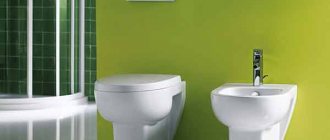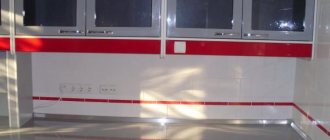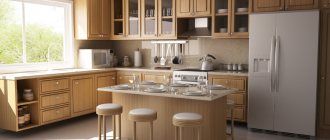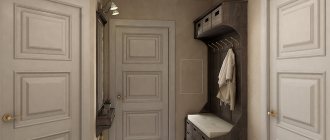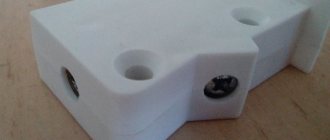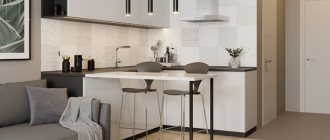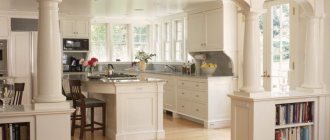The minimum distance from the toilet to the wall is a parameter determined by SNiP 2.08.01-89 “Residential Buildings”. SNiP are building codes and regulations developed back in Soviet times. But the distance from the wall to the toilet is not just the distance dictated by SNiP or GOST, because there are some standards in the production of building parts and plumbing equipment. These are documented optimal parameters obtained in a reliable way.
Toilet in the toilet
Dimensions and distances
To make visiting the bathroom comfortable, it is important to adhere to certain standards for the height of the installed toilet and the optimal distance between plumbing fixtures.
One of the most important indicators is the distance from the wall. If the toilet and bath are separate, then it is worth considering the following standards:
- The room intended for the toilet must be at least 0.8 * 1.2 m.
- The height of the bowl of the product must be at least 40 cm, while the height of the barrel is 81.5 cm, and the height of the drain pipe is 18.5 cm.
- If a bidet or washbasin is also installed in the room, the distance from the extreme point on the bowl to the middle axis of the bidet bowl should be at least 38 cm; the ideal distance is considered to be 45 cm.
- The distance between the wall and the middle axis of the bowl is at least 40 cm; for maximum comfort, it is recommended to install the product at a distance of 45 cm.
- For comfortable use, maintain at least 60-65 cm of free space in front of the product.
For a mixed bathroom, it is important to consider the location of all plumbing. For maximum convenience when using the bathroom, the minimum gap between its elements:
- The distance between the toilet and the sink is at least 20 cm.
- Ideally, the distance from the shower or bathtub should be at least 90 cm.
- From the toilet to the bidet - 30 cm.
In addition, when remodeling a bathroom, you need to place the plumbing fixtures at a distance from the riser that is suitable for its optimal operation. Increasing the distance between the pipes and the toilet can cause the water seal to fail.
Standard toilet sizes
Depending on the type of structure, it may have different dimensions:
- Floor. The compact toilet, which has a special shelf for the tank, has dimensions: Length - 610-645 mm; Bowl (width) - 345 and more; Height 370-395 mm. Plumbing without a shelf: Length - 435-460 mm; Width - 360 mm; height - 355-390mm.
- Suspension. Length - 470-700 mm; Width - 355-375 mm; height - max. 395 mm. In this case, the installation height can be adjusted independently.
- For children. Its length is 460-550 mm; width - 290-320 mm; height - 260-350 mm.
Peculiarities
Installing a toilet is a process associated with a certain list of features. To achieve the best operating conditions, they must be taken into account as a whole. The list of technical requirements that must be met may vary depending on the characteristics and purpose of the room in which the plumbing fixture will be installed.
Multi-storey residential buildings are built according to standard designs and have similar parameters. Sanitary facilities in apartment buildings are located along the vertical axis (riser) of communications: water supply, sewerage and heating (in some cases).
The design features of standard buildings do not allow the toilet to be placed in any location. Its installation point is tied to a specific area of the room. It should be located as close as possible to the vertical sewer riser.
Moving a bathroom to another location (remote from the one approved by the project) may lead to unforeseen disruptions in the operation of the building’s sewer system. Such transfer is prohibited by law.
Projects of multi-storey buildings are divided into 2 types:
- with a combined bathroom;
- with separate bathroom.
In the first case, the toilet is located in the same area as the bathtub and shower. In the second, it is located in a separate room. In both cases, the parameters of the distance to surrounding objects and walls established by GOSTs are applied to the location of the toilet.
Installation dimensions
Depending on the model and manufacturer of the product, its dimensions will also change. If you are planning another bathroom remodel in the future, it is recommended to install a toilet with an oblique projection. This will make it more mobile. In addition, to avoid difficulties, you must adhere to the following standards:
- If you have chosen a device with a horizontal outlet and started installing the toilet, then there should be a distance of 18 cm from the floor to the sewer outlet, and 20 cm for an oblique outlet.
- The dimensions of the opening for installing a toilet are also important. From the sides from the structure to the wall, at least 30 cm is maintained.
- The water pipe should be at a minimum distance for comfortable connection of a flexible hose to the tank.
How to move a toilet to another place: free 10-20 cm
If the toilet needs to be moved to a distance that does not exceed 20 cm, then the work will not be difficult. The placement of the equipment can be any. The main thing is to know the minimum distance not only in relation to pipes or walls, but also for the sink. To move the toilet to the left or right, you must first remove its connection from the elbows and the water supply. You should start by removing the old device. If the old toilet was installed with cement or special glue, then you will have to tinker with the removal. If you do just one wrong thing, the toilet may break.
Of course, if you plan to install a new device, then there is no need to be careful, but if this is not the case, then you need to turn off the water and carefully dismantle it
It consists of 3 steps:
- We eliminate it by placing putty in the space between the sewer pipe and the toilet outlet. In order to carry out this work, you can use a thin chisel or a flat-head screwdriver.
- We carefully begin to loosen the toilet. Here it would be appropriate to use a wide chisel, which needs to be hammered into different places. This action must be repeated until the device begins to swing thoroughly.
- We are trying to lift the device. To do this, carefully pull it towards you and remove the release along the axis. Experts say that if the device does not give in, then you should not use force; try to swing it even more and only then pull.
A toilet that was installed with standard fasteners and connected to the sewer with a rubber cuff will be much easier to remove. To remove it, you will need to remove the screws, which are the main fastening. After this, pull the device towards you and remove its outlet.
Also be extremely careful when removing the sealing putty. After all the dismantling work has been carried out, you can begin preparing to install the toilet in a new location.
Carefully inspect the flexible hose; if it is not long enough or it is leaking, you need to replace it with a new one. If you are satisfied with everything, we leave it in its old place. You can find out how the toilet looks in the corner, how to move it diagonally, lift it and place it on the podium in the photo; one day is enough for training.
Related article: Methods of attaching lining to the wall
Classification of toilets by type of installation
This product can also be divided into two categories, depending on the installation method: floor-standing and hanging. Floor-mounted ones, in turn, are divided into subcategories: wall-mounted and simple.
Floor-standing
This is the most common type of toilet. It is characterized by ease of installation and low cost. Typically, floor-mounted structures are installed in a more or less spacious room; for a room with a small area, a wall-mounted option (compact flush system) is more suitable.
Installing plumbing fixtures using anchor bolts does not require much time. The advantage of this type is that the floor covering does not suffer during installation.
Hanging
This type of toilet is installed in small rooms and saves a lot of space. The toilet mount can withstand a load of up to 400 kg, but there are models that can withstand more.
When installing, the device bowl is attached directly to the wall, at a certain distance from the floor. It is secured using either a frame or block method. To save space, sometimes such a toilet is installed in a special niche in the wall.
Calculation of toilet dimensions
Before installing plumbing fixtures, you need to choose a model that is suitable in size. It is recommended to focus on the largest family member and choose the appropriate option. If he is comfortable, everyone else will be comfortable using it too.
Installation
Installation of a new toilet is carried out after:
- preparing the necessary tools and materials;
- dismantling old plumbing fixtures;
- choosing a model and type of fastening.
To do this, a plan of proposed actions in the bathroom area is drawn up in advance.
Floor mounting options
- pedestal (tile) mounted on 2-4 dowels;
- anchors inserted into the floor during screeding and pouring;
- wooden base;
- special corners in the floor;
- glue.
In the latter case, an epoxy composition having a thickness of at least 4 millimeters is required.
Wall mounting options
Fastening to the wall is carried out only if the surface is load-bearing. A special metal frame is used for this. Anchors are first inserted into the wall and filled with cement. After they harden, you can hang the cistern.
How to connect to a plastic pipe
When connecting a toilet bowl to a plastic pipe, it is recommended to use a corrugated cuff. It will reduce the load on structural elements, since it can be bent at any angle. In the absence of corrugation, the use of plastic elbows of a suitable type is allowed. Using a sealant will prevent leaks.
In the old drain in the apartment
The old drain is pre-cleaned, after which special pipes are connected to it. Direct connection is only possible if the pipe diameter matches the toilet outlet. But even in this case, it is difficult to ensure tightness without a fixed plastic outlet.
Installation technology for compact models
Compact models are faster to install because they do not require separate installation of the drain tank on the wall. It is initially built into the toilet or screwed with fasteners that come with the kit. After this, the structure is installed on the floor, connected to the sewerage system, water supply system and started up.
How to properly install a toilet with a hidden cistern
A drain tank is placed in it and secured with dowels or screws. A water supply hose and a drain pipe are connected to it. Then a box-shaped extension is installed for the button on the latches, pressing which will provide flushing. The structure is walled up and connected to the toilet bowl using sealant.
How to install a toilet with a high cistern
Before installing the flush cistern, the toilet is mounted separately, after which markings are made on the wall. The container is placed at a height at which the drain hose will not bend much. The tank is hung on dowels secured to the wall using a hammer drill. A special adapter coupling is used to install the hose. The system is connected to the water supply and started.
How to connect a wall-hung toilet
The bowl is fixed at a height of 40-50 centimeters from the floor. The toilet is hung on strong dowels, embedded in the wall and capable of withstanding increased load. After this, communications are connected and the system starts. Typically, installing a wall-hung toilet requires the additional installation of a false wall, since it is almost impossible to hide all communications in any other way.
Without corrugation
A drain pipe is the best substitute for corrugation when connecting a toilet to a sewer. It is used if the pipes are not brought close to the system. Preliminary measurements are taken, after which a fan pipe with suitable dimensions and diameter is purchased. It is recommended to buy devices a few millimeters larger than required to ensure a margin.
Installation of a monoblock toilet
Installing any toilet is a complex procedure that requires careful measurements and sequence of actions. Unreliable fastenings and errors in connecting drains, sewerage and water supply will lead to negative consequences, due to which the work will have to be done again. To avoid problems, you should carefully study all the nuances in advance or seek help from professional plumbers.
We won’t teach you how to “pull apart the walls”, but we will tell you how to properly manage the available space
PROBLEM 1: It’s uncomfortable to wash
Place the bathtub against a short wall
If the length of the short wall of the bathroom is 160 cm or more, it is more logical to place the bath along it. With this arrangement, you will not only have a comfortable bathroom, but even an elongated rectangular bathroom will seem more proportional.
Fact:
Placing a bathtub along the long wall of a narrow room is not the best option. The room will seem like a pencil case.
PROBLEM 2:
It is difficult for an elderly person to get in and out.
Hang handrails
A safe, ergonomic and comfortable bathroom is unthinkable without grab bars to help you get out of the bathtub or shower. They are needed primarily in the bathrooms of apartments where elderly people or children live. It is convenient to place such a handrail at the waist level of the user standing in the bathtub: for a person of average height this is approximately 100 cm.
Find a barrel bath
It is believed that if there is no space for a bath, you need a cabin, and it can be organized in any area. In fact, this is “self-deception”: you can wash comfortably in a 90 cm font (pictured), the question is what kind it is. The same is true with a shower stall: you can arrange it even in a small space, but it will be inconvenient to wash in a cabin measuring less than 90 cm. What is better: installing a bathtub or a cabin if there is not enough space - everyone decides for himself.
PROBLEM 3: Distance in front of the toilet
For typical small-sized housing, this is a pressing issue: the toilet space is so small that, sitting on the toilet seat, you rest your head against the door. Is it possible to somehow increase the distance from the toilet to the door without remodeling by adding a hallway? Yes, but it all depends on your plans for renovation.
Find a compact toilet
If you have a typical separate toilet and do not intend to combine it with a bathroom, consider replacing the toilet. The distance from the toilet to the wall with the riser depends on two factors: the dimensions of the model and the type of its outlet (the angle of attachment of the pipe with the riser). If you find the same monoblock, but with a seat of less depth, you will gain 5–7 cm. Sometimes this is critical.
Schemes and standards for the placement and installation of plumbing equipment and appliances
Previously, waste and overflows were used in bathrooms, but then they became widespread for sinks.
Flat sink drain
In the case where the sink needs to be installed above the washing machine, as a rule, it has a flat shape. This saves space and is the most suitable option in this case.
Such a sink, which is called a “water lily,” must have a special flat drain. It must be included in the package, since it is almost impossible to select it separately.
In addition, the “water lily” is a sink with a side drain. Its peculiarity is that the hole for water drainage is located on the side, and not at the bottom. This may cause some inconvenience as the water may not drain completely. To avoid siphon blockages, you will need to remove the liquid yourself by soaking it with a rag.
If you are willing to put up with these shortcomings, this will allow you to free up additional space in the bathroom.
Therefore, the choice of sink drain should be given special attention as it will ensure the efficient operation of the system. Plumbing measures in the home can be divided into three types: Plumbing measures in the home can be divided into three types:
Plumbing measures in the home can be divided into three types:
- Maintenance work, for example, fixing a leaking faucet or clearing a clogged shower drain;
- Work to replace pipes or broken equipment;
- Installation of new plumbing and pipeline communications.
Routine plumbing repairs are not regulated by any regulations or standards. However, measures to replace pipes or install new plumbing equipment will necessarily entail the need for coordination with the relevant organizations, which will require strict compliance with the rules for installing plumbing fixtures in accordance with current standards.
The motivation of bureaucrats is simple and clear:
- The transfer of utility networks and the installation of plumbing fixtures in a new location is called redevelopment, which may entail changes in the configuration and size of the room, requiring changes to the apartment’s registration certificate;
- Relocating plumbing fixtures is also a remodel.
Naturally, it is easier to do everything according to the letter of the law, then the preparation of technical documentation for housing will not cause problems.
- SNiP 2.08.01−89* “Residential buildings”;
- SNiP 2.04.05−91* “Heating, ventilation and air conditioning”;
- SNiP 3.05.01−85 “Internal sanitary systems”;
- SNiP 2.04.01−85* Internal water supply and sewerage of buildings.
The modern market of plumbing equipment is represented by a wide range of bathtubs, showers, sinks and sinks, toilets and bidets, valves and mixers. Despite all the variety of devices in terms of functionality and methods of controlling their operation, the methods of connecting household sanitary equipment with residential pipeline communications are completely unified and “submit” to the requirements of GOSTs and SNiPs.
It is recommended to install household plumbing after installation of utilities before finishing the room. Water connections for installing appliances must end with water sockets, which are a mandatory attribute of a home’s water supply system. Water outlets are specially rigidly fixed to protect the water supply system from vibration effects that occur during the operation of connected household plumbing fixtures.
The distance between the axes of the outlet fittings provided for hot and cold water must be strictly 15 cm.
Instead of sockets, it is allowed to use elbows, tees, couplings or manifolds for connecting mixers or other types of taps.
Another general requirement for the installation of plumbing fixtures is to ensure free access to the equipment, for which SNiP stipulates the size of the free space around each type of fixture (bathtub, washbasin, etc.).
The height of placement of plumbing fixtures is regulated in clause 3.11 and clause 3.15 of SNiP 3.05.01−85 “Internal sanitary systems”, and pipeline fittings to the devices are installed in accordance with clause 10.5 of SNiP 2.04.01−85* “Internal plumbing and sewerage of buildings."
Distance from wall to toilet: optimal bathroom layout
When renovating a toilet and bathroom when replacing plumbing fixtures, the problem of proper bathroom layout arises. One of the most important convenience parameters is the distance between the wall and the toilet, since if it is chosen incorrectly, using the device will be uncomfortable.
We will look at the regulatory requirements and find out what basic distances are determined by the instructions.
A wall-mounted toilet should be installed in accordance with minimum or optimal convenience standards.
Exceptions to the rules
There are exceptions to the norms that determine the optimal location of the toilet. Their presence is determined by the technical characteristics of the room.
In buildings not built according to standard designs (private houses, shops, cafes and others), the standards for the location of a sanitary facility may not be observed.
The reason for this may be: insufficient free space, the location of communications or the personal desire of the owner.
Violation of technical regulations for the location of a toilet is not a violation of the provisions of any law if this sanitary point is located in a non-state institution or outside a special purpose facility: hospital, kindergarten, school, military unit and the like. The owner of the premises is free to determine the location of the bathroom.
Bathroom remodeling
Separate toilet location
In the case of a separate bathroom, the layout is somewhat simpler.
Let's start with a simpler case, when the toilet is separated from the bathroom. It is simpler because in such a toilet, as a rule, there is one device. A bidet can be added to the maximum configuration if the size of the room allows.
We will immediately announce the standards for the distance from the wall to the toilet adopted in SNiP 2.08.01-89* “Residential buildings”:
- The minimum dimensions of the toilet room are 800 mm width and 1200 mm length . In this case, the average dimensions of the compact are taken to be 650 mm in length and 350 mm in width;
- According to the standard, the height of the toilet bowl should be 400 mm, the height of the tank should be 815 mm, the height of the drain pipe should be 185 mm;
- If a bidet is installed in the room, then the gap from the edge of the compact bowl to the middle axis of the bidet bowl should be at least 380 mm, and for maximum comfort - at least 450 mm. The same standards apply if there is a washbasin nearby;
- The minimum distance from the toilet to the wall located in the front (front) must be at least 530 mm, and for maximum comfort - at least 760 mm;
- The space from the middle axis of the bowl to the side wall is at least 400 mm, for optimal operation mode - at least 450 mm.
Minimum distance from the toilet to the wall: norms on the side, between the center and the edge
The minimum distance from the toilet to the wall is a parameter determined by SNiP 2.08.01-89 “Residential Buildings”. SNiP are building codes and regulations developed back in Soviet times. But the distance from the wall to the toilet is not just the distance dictated by SNiP or GOST, because there are some standards in the production of building parts and plumbing equipment. These are documented optimal parameters obtained in a reliable way.
Conclusion
When remodeling bathrooms and toilets, you should take into account the distances between adjacent appliances, and also remember the distances from the walls (see also the article “Bidet toilet: purpose and design features”).
Most often, owners are guided by considerations of personal convenience, but knowledge of building codes is also useful. The video in this article demonstrates the most acceptable solutions for planning the interior of a toilet room.
Did you like the article? Subscribe to our Yandex.Zen channel
SNiP norms 2.08.01-89
Until recently, the Russian Federation mainly used the standards of the Soviet state, which paid great attention to the construction, industrial, epidemiological and occupational safety of its citizens.
Recognizing the appropriateness of the data presented in these documents, obtained not just empirically, but also on the basis of scientific research, the norms and rules were still used at the level of recommendations.
Over time, the need for the existence of such norms of a legislative nature was discovered.
The court took them into account when resolving disputes, but could also ignore them.
The creation of a state register of regulatory recommendations, norms and rules, as well as methodological guidelines led to the fact that the developed norms and rules in the field of construction, production and the national economy acquired the status of official and legally enshrined. The main condition for acceptance was compliance with the norms of Russian law.
Sanitary and hygienic standards (SanPiN) are not only not outdated, but have become even more relevant due to the deteriorating epidemiological and environmental situation. None of the adopted sets of rules, according to the laws of the Russian Federation and regulations of the Ministry of Health, should conflict with the standards of sanitation and hygiene.
Distance norms
The distance of the toilet bowl from the side wall is the norm dictated by SanPiN for the normal implementation of treatment with disinfectants or disinfectants in areas of potential danger of contamination by pathogenic agents.
This piece of plumbing must be kept in perfect cleanliness; the edge of the toilet bowl is especially carefully disinfected. This is especially true if there are small children in the family. The wall close to the toilet and the floor in the room are also treated. But if the minimum specified parameter is not met, it will be problematic to carry out the necessary procedures.
Gosstandart dictates installation standards, because they have already been determined and verified as optimal and convenient sizes, distances and distances. If you adhere to the standards, you can avoid possible negative consequences.
The distance from the wall when installing the toilet, as well as the parameters of the toilet itself, are aimed at human convenience, creating optimal conditions for a comfortable, hygienic and safe discharge of natural needs.
Bathroom ergonomics: layout
You should not fill a small bathroom with equipment and objects, because if it is impossible to properly dry yourself with a towel and get dressed in the bathroom, this will cause discomfort. It should be possible to freely spread your arms to the sides to dry yourself - for this you need at least 170 cm of free space. In addition, the bathroom should have enough space for a person to bend over while standing on the floor (apply cream to his feet, dry himself, undress and get dressed).
SNiP “Residential Buildings” on distance standards
The rules contained in the regulatory document are mandatory for the construction of any type of building - industrial, public, medical, educational and residential. However, there is an unspoken opinion that owners of premises in residential buildings and private buildings can deviate from the dictated standards if they themselves carry out their maintenance and operation.
Basically, such a retreat is made by the owners of premises with bathrooms, combined or frankly small. If the toilet is spacious enough, it is better to adhere to the established rules in order to use special rooms with convenience and safety:
- to the front (front) wall or wall with a door, if we are talking about a small toilet, the minimum distance is 53 cm. This is enough to not feel tightness in the knee joint;
- the maximum required distance from the frontal plane located in front of the seated person is 76 cm;
- the maximum distance from the front does not particularly need to be regulated, and if possible, the functional zone for a person can be more than a meter;
- from the middle axis of the toilet to the side wall, the established minimum is 40 cm. In some sources it is defined as 38 cm;
- the optimal distance from the central axis of the toilet is 45 cm. This is enough for comfortable operation of the plumbing fixture. But no one forbids installing at a greater distance, if the parameters of the allocated room allow it;
- in a separate toilet, the distance between the toilet and the wall on the left in standard buildings is usually equal to the distance to the wall on the right side;
- The location of the toilet in the toilet room is usually the center of the room, because the sewer pipe is supplied here. This also determines the position of the remaining toilets on the riser on the floors above and below;
- The second option for placing plumbing equipment is closer to the back wall. This does not make it possible to equip some kind of shelves or rack, but it is typical for the minimum dimensions of the toilet in apartments of standard construction, where the bathroom is separate;
- The toilet stall in Soviet-era houses was built according to size, when the central placement provided the necessary distances to the side wall and front surface with the entrance door located in it.
When arranging a shared bathroom, there are certain conditions that must be observed. These are standards for the distance of the toilet from other interior items that should be adhered to, even minimally.
If the distance between the necessary furnishings does not meet accepted standards, zoning or partitions can be used.
But this is not a suitable option if the dimensions of one of the family members do not correspond to the average figures for which the building codes and standards are calculated.
Recommendations
There are factors why it is worth observing the standards for the location of the toilet even in non-standard rooms. Among the main reasons are the following:
- standardized parameters of the shape and size of household items that are installed in the bathroom or near the toilet (if combined);
- availability of optimal options for the location of sewer drainage node connections;
- fixed dimensions and shape of plumbing components;
- Features of toilet installation technology.
Household items that may be located near the toilet (sink, sink with cabinet, washing machine, dryer and others) are manufactured according to a single range of standards. The overall dimensions of the toilets also correspond to them. This means that non-compliance with GOSTs that determine the distance for installation may lead to a violation of ease of use in the use of all household items for complex purposes.
Regardless of the characteristics of the room, there are standards that determine the best result of using the toilet. What matters is the angle of inclination at which the drain and its inlet socket are located. Even if the room is not built according to a standard design, the value of this slope remains unchanged.
To comply with this requirement, it is necessary to place the toilet at the optimal distance from the sewer inlet. Placing it too close will make it difficult to flush. Positioning too far apart may result in subsequent deflection of the corrugated connector. As a result, under the influence of deformation, leaks may appear in the area of the connections of the corrugations and sockets.
Plumbing components are manufactured according to uniform standards.
This fact should be taken into account when choosing the location of the toilet. Incorrect selection of the distance may make it impossible to use some plumbing fixtures. For example, placing the housing too close to the shut-off valve may interfere with the operating stroke of its lever, which will lead to the impossibility of shutting off the water supply.
The toilet is installed on a vertical support, which has 2 or 4 holes for fasteners. Before installation, it is necessary to mark these fasteners. To do this, the device is installed at its final location. Marks are made through the mounting holes on the floor. If the toilet is located too close to the wall, marking will be extremely difficult.
To install fasteners, holes are drilled in the floor in accordance with the markings. After placing the toilet in place, fasteners are inserted into the holes - bolts or dowel-nails. Screwing in these fasteners will also be difficult if the toilet is located too close to the wall or other furnishings.
In the next video you will learn important nuances that need to be taken into account when installing a toilet.
Average social standards
Standards for installing a toilet away from the wall are the results of measurements, studies, social and statistical surveys that allow us to develop standards for continuous production. Some of them were included in GOSTs and SanPiN and became standard standards for the sale of industrial products in construction markets and building materials supermarkets.
The children's toilet was developed according to standards obtained in pediatrics, where there are standard standards for each age - weight, height. Children who do not meet age standards have to adapt to any preschool educational institution - be it a kindergarten or a school.
At home, not everyone has the extra square meters and funds to install a special device. It is much more rational to use a special toilet stand. Social standards concern standardized equipment and room size.
If there are people who do not meet these parameters, they are inconvenienced or (if they have significant funds) they create toilets and buy custom toilets. The average size standards are as follows:
- The most common toilet size: bowl height - 40 cm, tank - 81.5 cm, drain pipe rises 185 cm. The compact itself is most often 65 cm long and 35 cm wide. It follows that from the central axis of the device to its edges can be at least 17.5 cm, if this is an adult and not a child’s version. Then it is clear why on a construction forum, when asked how many centimeters should be the minimum distance, they write that it can be 38 cm, and the distance from the toilet to the side wall is at least 20 cm. In total, 17.5 cm (almost 18 cm) from the central (longitudinal) axis of the bowl and 20 cm recommended to the wall, and give those 38 cm (minimum). And if you follow the SNiP standards and make 45 cm from the axis to the wall, then this will be the optimal average parameter, convenient for most people.
- For a toilet room, according to building regulations, 80 cm in width and 1 m 20 cm in length are considered sufficient for a comfortable stay and the exercise of natural needs. When converting old secondary housing, the length and width are often made smaller. Sometimes in this way meters are gained in the hallway or kitchen. In this case, they usually bring the bathroom and toilet closer together or expand the space by changing the layout of the bathroom and installing a shower stall. But in houses of mass standard construction with a separate toilet, there is often a size determined by GOST and SNiP, corresponding to SanPiN standards and providing maximum convenience to people living in the apartment.
What exceptions might there be?
However, the above is not an entirely suitable option when the size of one of the family members does not correspond to the average figures for which building standards and regulations have been developed. Standards for installing a toilet against the wall are the consequences of measurements, analyses, statistical and social surveys, which make it possible to develop standards for mass production. Some of them were included in SanPiN and GOST standards and became standard templates for the sale of industrial products at construction markets and building materials hypermarkets.
For example, a toilet for children was created according to standards taken from pediatrics, where there are standard indicators for any age - height, weight.
Children who do not meet age-related development standards have to adapt to any institution - be it kindergarten or school. At home, not everyone has the extra space and money to install special devices. It is much wiser to use a specialized toilet stand. Social regulation concerns standardized equipment and the size of premises.
If there are people who do not fit these parameters, they either endure discomfort or (if they have the finances) purchase toilets of a non-standard type. Although the rules are immutable when constructing any types of structures - educational, residential, medical, public and industrial.
Nevertheless, there is an unspoken belief that apartment owners in residential buildings and individual buildings can deviate from the dictated standards when they independently use and maintain plumbing fixtures.
As a rule, such a retreat is made by the owners of apartments with combined bathrooms . When the restroom is quite spacious, it is safer to follow the established rules in order to use the special premises comfortably and safely.
